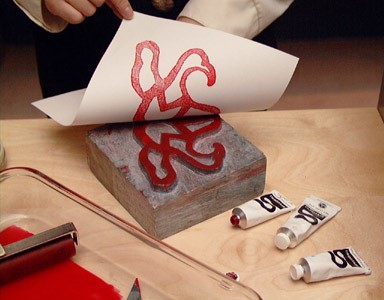Stonecut Printing
Printmaking is a relatively new art form for the Inuit. The first prints were created through trial and error in the settlement of Kingnait (Cape Dorset), on Baffin Island, in Nunavut, Canada. Printmakers determined that stone was the best medium on which to work because it was readily available, and because the Inuit had been carving it for thousands of years. The Cape Dorset arts cooperative invited artists to contribute drawings or paintings for distribution. The cooperative selected 50 images and produced 50 prints of each one. The profits from their sale were shared throughout the community. This practice spread throughout Canada to other settlements like Baker Lake and Povurnituq.
Stonecut printing process. Photo by Harry Foster. Image courtesy of the Canadian Museum of Civilization.
The stonecut printmaker begins by copying an original drawing onto a flattened stone block. He or she then chips away all unnecessary stone, leaving a raised surface that replicates the image from the original drawing. Using a special tool, called a brayer, the printmaker rolls colored inks onto the surface of the stone. He or she then lays a sheet of thin paper on the inked block and rubs the back of the paper by hand. After the ink has soaked into the paper, the printmaker peels the paper from the stone block to reveal a sharp printed impression. The image appears in reverse from the original drawing.
Detail from Mary Ashevak Ezekiel, Canadian (Inuit), born 1932; Printer: Lukta Qiatsuk; Publisher: West Baffin Eskimo Cooperative, Woman Sewing Skin Boots, 1960. Stonecut print on paper, edition 32/50, sheet: 12 3/4 × 19 1/4 in.
Most of the print shops throughout the Arctic follow the practices of traditional Japanese printmaking—that is, artists created the drawings and skilled Inuit printers produced the prints. Like Japanese printmakers, Inuit printmakers credit the artist who drew the original image, the printmaker who chose where to place the image on the page and produced the edition of multiple prints, and the cooperative printmaking shop where the process took place. In each print, a symbol or “chop” identifying each contributor appears. In this detail from Mary Ashevak Ezekial's print Sewing Skin Boots <link> the top chop is the signature of the artist written in Inuktitut syllabics; the second is that of the printer; and the bottom chop, in the shape of an igloo, is the symbol for the West Baffin Eskimo Cooperative.
Learn More
Visit the Canadian Museum of History website <link to http://www.historymuseum.ca/cmc/exhibitions/aborig/iqqaipaa/artmak-e.shtml> to learn more about contemporary Inuit stone carving and stonecut printing.


